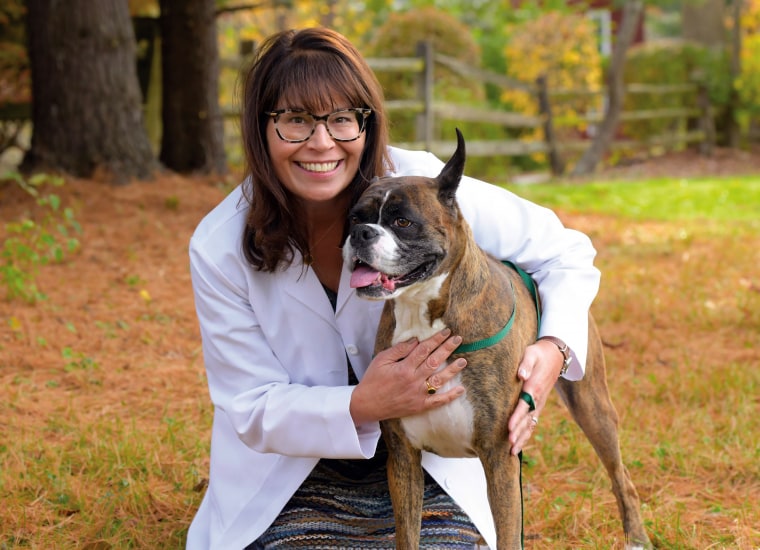We think of cancer as a uniquely human affliction, but the disease takes a toll on dogs, cats and many other animals. Even dinosaurs had malignant tumors in their bones, fossils have revealed.
When our furry companions develop cancer, they undergo some of the identical treatments human patients receive, including radiation and the same chemotherapy drugs — though most don’t lose fur with chemo.
As a veterinary oncologist for more than 20 years, Dr. Renee Alsarraf has treated countless of pets with cancer. Then, in the summer of 2018, she was diagnosed with the disease herself: endometrial cancer, which starts in the inner lining of the uterus.
“Hopefully, this will be a cautionary tale for women,” Alsarraf, 55, who lives in Montclair, New Jersey, told TODAY. “I had no clinical signs. I didn’t lose any weight. I wasn’t lethargic.”

Her cancer was found during a routine annual gynecological exam. Surgery revealed it had stealthily spread outside of her uterus to her uterosacral ligament, which meant she had to undergo 25 doses of radiation and “a whole bunch of chemotherapy,” Alsarraf said. The surgeon who spotted the tiny metastasis likely saved her life.
Even though she had devoted her career to treating cancer, the veterinarian struggled to cope with her own diagnosis until she drew inspiration from her four-legged patients and family pets.
Cats and dogs live carefree in the moment, don’t waste their time with worry, don’t dwell on how much longer they have to live and never understand why their human is so sad, Alsarraf writes in her new book, “Sit, Stay, Heal: What Dogs Can Teach Us About Living Well.”
She shared her experience with TODAY:
Why does cancer affect so many living beings?
Sadly, it is not surprising that animals and people get cancer. Every single day, we have little missteps to our DNA. Our body often is either able to fix that strand of DNA or able to stop that that little cell from dividing.
As animals and people get older, our repair processes and our ability to even realize there was a misstep slows down. Sometimes, that cell doesn’t die and becomes cancer. It's now able to divide uncontrollably.
Lymphoma is the most common cancer in dogs and cats. Most all of the drugs that we use are the same that are used in people, obviously at a different dose. Thankfully, dogs have different or fewer side effects.
I can say the word “cancer” for my patients, but when it came to me, I got weak in the knees and I didn’t want to associate my name with that disease. I called it the “C word.” It’s now a lower case “c” so I’m giving it less significance. If you and I were talking in person, I’d be giving it the middle finger.
As a patient, what stood out to you about human medicine versus animal medicine?
When someone comes in with their pet, I believe knowledge is power, so I tell them all about the disease, the different treatment options. We go over the different side effects, what the difference would be in prognosis and in cost. That way they can make the best informed decision for their pet and their family.
When we go see our physician, we’re given one plan to follow, which we often do blindly. We’re not given the different options. We don’t hear about the different protocols and what they could be. For me, it was harder to just follow along blindly.
The other part that was hard for me is none of my doctors ever spoke about prognosis. In veterinary medicine, we will often say, for the average dog, there’s a certain percent that go into remission and that remission lasts a certain amount of months or years.
But no one — not the surgeon, radiation oncologist, the medical oncologist — would tell me when I asked. Their rationale, which I understand, was it doesn’t really matter what the masses do, it only matters what you do. If you’re that 10% who does very poorly or you’re the 20% that just beats all the odds, it doesn’t matter what the averages are.
My guess is if they told you it wasn’t going to be great, maybe then you’d go in with a negative attitude, and obviously you always want to have a positive attitude.
What lessons did you learn from your animal patients about getting through your treatment?
We can use dogs as guides during our struggles. They never waste their time with worry. I try to continually remind myself: Where has the worrying ever gotten me? It tends to be our way of trying to control something that we have no control over. But it is such negative energy that only serves to bring us down, especially in times of stress or trouble. I know my dog is happy every day when the sun comes up. It’s just such a nicer, better way to live.
We have our dogs living right with us demonstrating that on a daily basis and maybe if we can just try to remember to pause and take a look at them as a reminder.
Another lesson is that dogs never judge us. It doesn’t matter if you just lost your job or you misspoke and felt like a fool. They never judge you. I have this voice in my head that can be terribly harsh and judgmental to myself. Sometimes, she doesn’t shut up and that’s not a good way to live. It certainly just serves to bring us down. Dogs never have that. When I was lying on the sofa with my scraggly chemo hair plastered to my head, my dog loved me and looked at me as adoringly as ever.
Dogs meet us where we’re at and we can just be ourselves. It should be OK that we love, accept and cherish ourselves in our own heads.
This interview was edited and condensed for clarity.
